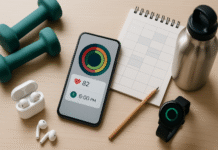When you eat mindfully, you know exactly what you’re putting into your body and what you’re drinking. It means being aware of the colors, smells, textures, tastes, temperatures, and even the sounds (like “crunch!”) of our food. Mindful eating also asks us to notice the thoughts, feelings, and physical sensations that come up during a meal, like hunger, satisfaction, cravings, guilt, and joy, without judging them. With all the digital distractions and never-ending tasks we have to do, meals often become an afterthought. We eat them quickly and don’t think about them between meetings, commutes, or screen time. This pattern can make us ignore our body’s natural signals of hunger and fullness, make us eat too much, and hurt our relationship with food.
Mindful eating not only helps us enjoy and appreciate food more, but it can also help us digest food better, keep our weight in check, feel less stressed about eating, and be nicer to ourselves. If you want to stop eating when you’re upset, slow down during meals, or just enjoy every bite, the eight tips below will help you build a healthy, long-lasting relationship with food.
The Science of Mindful Eating
Studies have shown that being aware of what you’re eating is good for your body and mind. The Journal of the Academy of Nutrition and Dietetics published a study that showed people who practiced mindful eating for eight weeks had fewer binge eating episodes and felt better emotionally than people who didn’t. Neuroimaging studies show that mindfulness training can change how brain areas that deal with self-control and reward processing work. This means that being aware of what you’re eating can help you stop eating when you’re hungry or angry.
Eating more slowly helps the cephalic-phase digestive responses, which include making saliva and releasing digestive enzymes. This helps your body break down and absorb nutrients more easily (Mayo Clinic, 2023). It also gives hormones like cholecystokinin (CCK) time to tell the brain that you are full, which lowers the risk of eating too much. Mindful eating isn’t just a fad that makes you feel good; it’s a scientifically proven way to improve your mental and physical health.
Tip 1: Begin with a Goal
Before you even take a bite, stop and think about what you want to get out of your meal. What do I really want to eat? Physically, emotionally, or spiritually? This simple ritual helps you find meaning in your life and brings your attention back to the present.
Try this: Put your hand on your heart, close your eyes for a few breaths, and say something like “I choose foods that nourish me” or “I eat with gratitude.”
Why It Works: Setting intentions gets the prefrontal cortex ready, which helps with self-control and sets the stage for a mindful mindset from the start.
Tip 2: Use All Five of Your Senses
By doing this, you can make every meal a multisensory experience.
- See: Take a look at the colors and the way your food is set up on the plate.
- Smell: Take a deep breath to enjoy the smells.
- Touch: Feel the textures of the smooth avocado and the crunchy carrots.
- Hear: Listen for sizzles, crunches, or soft bites.
- Taste: Take your time to find the sweet, salty, bitter, sour, and umami flavors.
When you pay attention to your senses on purpose, you ground your awareness and make things more fun. This usually means smaller portions and more happiness.
Tip 3: Don’t Rush and Chew Your Food Well
Try to chew each bite at least 20 to 30 times, even if the food is soft. This not only helps your stomach digest food, but it also makes the meal last longer, giving your brain time to figure out that you’re full.
Try this: Put your utensils down between bites, take a breath, and chew until the last bite is completely broken down before you swallow.
Benefit: Chewing more slowly lowers the glycemic response to carbs, which helps keep blood sugar levels stable and stops cravings in the middle of a meal.
Tip 4: Be Aware of How Hungry and Full You Are
Instead of following a random “empty plate” rule, pay attention to how hungry and full you are (0 means you’re starving, and 10 means you’re too full). You should start eating between 3 and 4 on the scale and stop between 6 and 7, leaving a little room for satisfaction without pain.
Try this: Stop eating in the middle of a meal to see how full you are.
Evidence: Knowing what your body is telling you can help you eat less and keep your weight in check over time.
Tip 5: Figure Out What Makes You Feel Bad
When you eat because you’re stressed or upset, it can look like you’re physically hungry. If you want to snack between meals, ask yourself if you’re bored, stressed, sad, or tired.
Try this: Give the feeling a name, like “I see that I’m stressed.” This is a way to be more aware of yourself. Just saying its name can make it less intense, which can make you want to eat less to feel better.
Another option is to do a short breathing exercise or go for a walk if the urge doesn’t go away. Most of the time, the craving will go away in 10 to 15 minutes.
Tip 6: Don’t Let Anything Else Get in the Way of Your Meal
Even if you’re eating by yourself, turn off your TVs, phones, and laptops and sit down at a table.
Why It Matters: When you eat while you’re distracted, you eat more and forget what you ate, which makes it more likely that you’ll eat too much later.
Tip: Before meals, listen to soft instrumental music or think about what you’re thankful for for five minutes to be more present.
Tip 7: Keep Track of How Much You Eat
Using smaller plates and bowls will help you eat less without trying. The Academy of Nutrition and Dietetics says that before serving, you should divide the plate into four parts: half for vegetables, a quarter for lean protein, and a quarter for whole grains or starchy vegetables.
Mindful Check: After you put your food on a plate, take a moment to look at it before you eat. This will help you make choices that are more aware.
Tip 8: After Your Meal, Think About It
Take a minute or two to think about what you did after you were done:
- What tastes or feelings stood out?
- How do I feel in my body? Am I full of energy, tired, or in the middle?
- What emotions did you have during the meal?
Writing down these observations in a journal can help you see patterns, such as which foods give you energy and which ones make you tired or guilty. This can help you make better choices in the future.
How to Avoid Common Mistakes
- Impatience: If you feel rushed, make sure to set aside time in your calendar for meals.
- Perfectionism: You might get mad if you “fail” at being aware. Instead, treat each meal as a new chance. It’s very important to be nice to yourself.
- Social Pressures: Eating with people who don’t care about what they eat? You could suggest a mindful eating challenge or show them how to do it by serving and eating mindfully.
It takes work to be mindful, just like any other habit. Start with one tip at a time. For example, for a week, focus on chewing slowly, and then add more tips on top of that.
Every Day Putting Mindful Eating into Action
To fit mindful eating into your busy life:
- Micro-Moments: Even if you’re short on time, take two deep breaths before you eat.
- Mindful Snacking: Don’t eat snacks right out of the bag; instead, put them in small containers first. Before you move on to the next part, take a second to see how hungry you are.
- Meal Prepping with Intention: Be fully involved in the process of planning meals. Pick out bright fruits and vegetables, smell fresh herbs, and feel the textures as you chop. This gets people excited about eating and makes them more aware of what they’re eating.
- Habit Stacking: Connect mindful eating to something you already do. For instance, say that you will use tip 2 (engaging the senses) every time you make tea.
These small, planned actions will add up over time to change not only how you eat, but also how you feel about food in general.
Finally
Mindful eating isn’t just a way to lose weight; it’s also a way to get to know food, ourselves, and the world around us better. By encouraging presence, compassion, and awareness, we can have a healthy, long-lasting relationship with food that respects what our bodies and minds need. These eight tips will help you make every meal a time to take care of yourself and eat well. Setting goals, paying attention to your senses, paying attention to your hunger and fullness, and thinking about your meals on a regular basis are all things they suggest. Enjoy the journey; every bite you take with care is a big step toward better health.
Frequently Asked Questions (FAQs)
1. What is the difference between mindful eating and intuitive eating?
Being aware of your thoughts, feelings, and senses while you eat is what mindful eating is all about.
Intuitive eating is based on the idea that you should listen to your body’s hunger and fullness signals, not follow diet culture, and have a peaceful relationship with food.
2. How long does it take to learn how to eat mindfully?
It’s very important to be consistent. People notice benefits right away, like eating less and feeling better, after doing it regularly for 2 to 4 weeks. It usually takes 8 to 12 weeks of hard work to change a habit for good.
3. Does being aware of what you eat help you lose weight?
Mindful eating isn’t a weight-loss plan on its own, but it can help you eat smaller portions, eat less when you’re feeling emotional, and know when you’re full. All of these things are good for keeping your weight down over time.
4. Is mindful eating good for people who have problems with food?
People with clinical eating disorders should work with a qualified mental health professional or registered dietitian who has experience treating eating disorders to make sure they do it safely. Mindful eating can be helpful, but it can also be dangerous.
5. What if I lose my focus while I eat?
It’s normal to lose your focus. Don’t judge the distraction; just notice it and then go back to focusing on the meal. Your times of being mindfully focused will get longer over time.
6. Can you eat mindfully while you’re with friends or family?
Of course. Get your loved ones involved by turning off screens, saying thanks, or noticing flavors out loud. This will make meals into times for everyone to be mindful.
References
- Harvard T.H. Chan School of Public Health. “Mindful Eating.” 2021. https://www.hsph.harvard.edu/nutritionsource/mindful-eating/
- University of California, Berkeley, Greater Good Science Center. “How Mindful Eating Can Help You Lose Weight.” 2020. https://ggsc.berkeley.edu/mindful-eating
- Mayo Clinic. “Mindfulness Nutrition: The Art of Eating Mindfully.” April 5, 2023. https://www.mayoclinic.org/healthy-lifestyle/nutrition-and-healthy-eating/in-depth/mindful-eating/art-20046356
- American Dietetic Association. “Portion Control Guidelines.” 2024. https://www.eatright.org/food/planning-and-prep/portion-control
- National Eating Disorders Association (NEDA). “Mindful Eating and Eating Disorders.” 2024. https://www.nationaleatingdisorders.org/mindful-eating
- Amir, Amitay & Goldstein, Sara. “Emotion Labeling as an Intervention for Emotional Eating.” Appetite. 2021.
- Neufcourt, L. et al. “Chewing Patterns and Satiety Hormones: A Controlled Trial.” Endocrinology & Metabolism. 2022.
- Robinson, E. et al. “Distracted Eating and Energy Intake.” Obesity Journal. 2018.
- Tribole, Evelyn & Resch, Elyse. Intuitive Eating: A Revolutionary Program. 2023.
- Wansink, Brian. “Portion Distortion: Serving Sizes in the 21st Century.” Journal of the Academy of Nutrition and Dietetics. 2019.




































